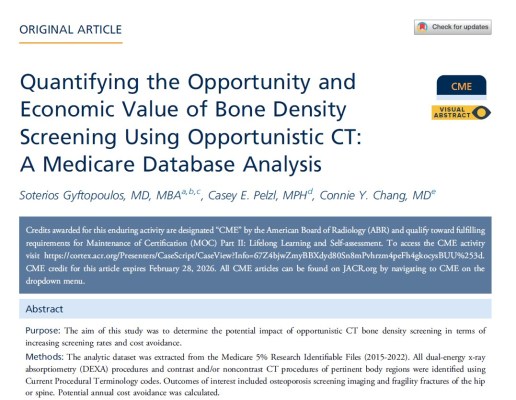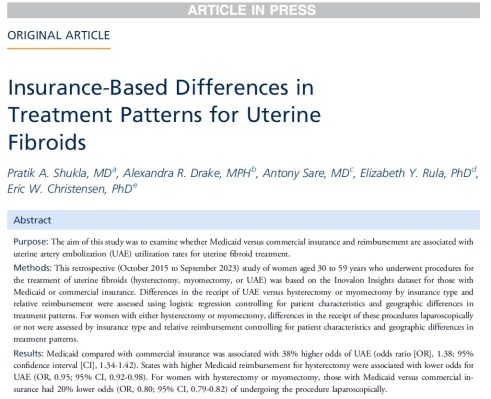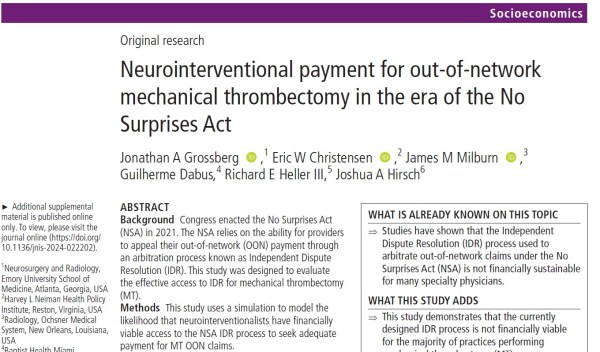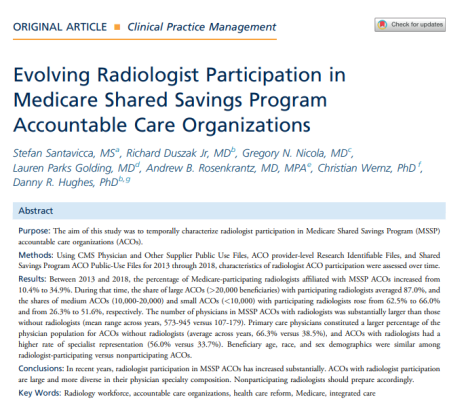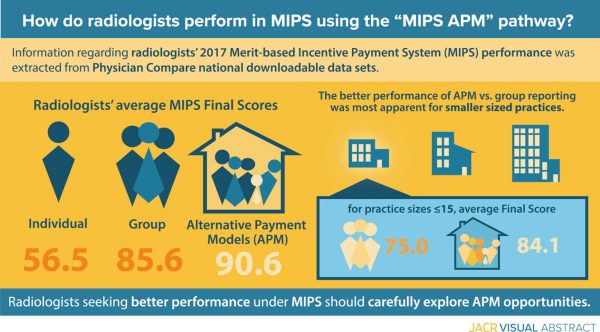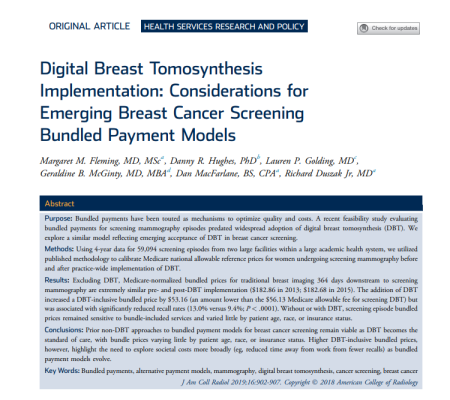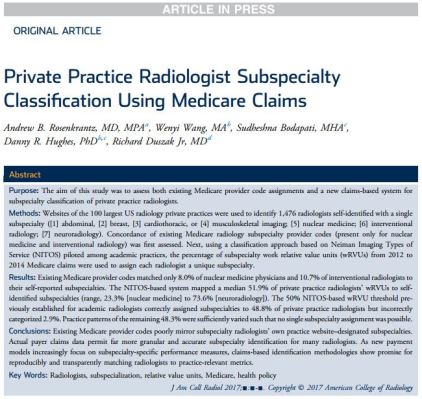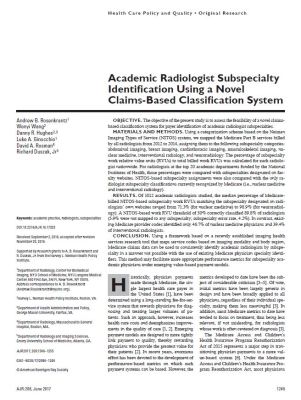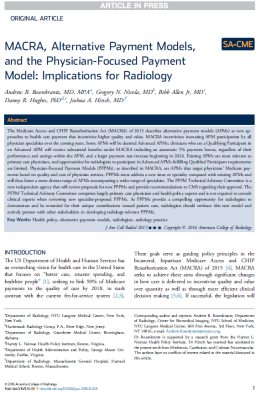The aim of this study was to determine the potential impact of opportunistic CT bone density screening in terms of increasing screening rates and cost avoidance. Full Article
Soterios Gyftopoulos, MD, MBA, Casey E. Pelzl, MPH, Connie Y. Chang, MD. 2025. "Quantifying the Opportunity and Economic Value of Bone Density Screening Using Opportunistic CT: A Medicare Database Analysis," Journal of the American College of Radiology (JACR)
The Merit-Based Incentive Payment System (MIPS) is the largest pay-for-performance program that links reimbursement to performance of Medicare clinicians. This study evaluated radiologist performance in the 2019 MIPS program and predictors of scores and underperformance. Full Article
YoonKyung Chung, PhD, Chi-Mei Liu, PhD, Lauren P. Nicola, MD, Elizabeth Y. Rula, PhD. 2025. "Factors Influencing Radiologist Performance in the Merit-Based Incentive Payment System," Journal of the American College of Radiology (JACR)
The aim of this study was to examine whether Medicaid versus commercial insurance and reimbursement are associated with uterine artery embolization (UAE) utilization rates for uterine fibroid treatment. Full Article
Pratik A. Shukla, MD, Alexandra R. Drake, MPH, Antony Sare, MD, Elizabeth Y. Rula, PhD, Eric W. Christensen, PhD. 2025. "Insurance-Based Differences in Treatment Patterns for Uterine Fibroids," Journal of the American College of Radiology (JACR)
Congress enacted the No Surprises Act (NSA) in 2021. The NSA relies on the ability for providers to appeal their out-of-network payment through an arbitration process known as Independent Dispute Resolution. This study was designed to evaluate the effective access to IDR for mechanical thrombectomy. Full Article
Jonathan A Grossberg, Eric W Christensen, James M Milburn, Guilherme Dabus, Richard E Heller III, Joshua A Hirsch. 2024. "Neurointerventional payment for out-of-network mechanical thrombectomy in the era of the No Surprises Act," Journal of NeuroInterventional Surgery
The aim of this study was to temporally characterize radiologist participation in Medicare Shared Savings Program (MSSP) accountable care organizations (ACOs). Full Article
Stefan Santavicca, MS, Richard Duszak Jr, MD, Nicola Gregory, MD, Lauren Golding, MD, Andrew Rosenkrantz, MD, Christian Wernz, MD, Danny Hughes, PhD. 2021. "Evolving Radiologist Participation in Medicare Shared Savings Program Accountable Care Organizations," Journal of American College of Radiology (JACR)
October 30, 2019
This study assessed radiologists’ performance in the Merit-Based Incentive Payment System (MIPS), with attention to the impact of the novel MIPS-Alternative Payment Models (APMs) participation option created under the Medicare Access and CHIP Reauthorization Act. View Infographic
Bundled payments have been touted as mechanisms to optimize quality and costs. A recent feasibility study evaluating
bundled payments for screening mammography episodes predated widespread adoption of digital breast tomosynthesis (DBT). We
explore a similar model reflecting emerging acceptance of DBT in breast cancer screening.
Methods: Using 4-year data for 59,094 screening episodes from two large facilities within a large academic health system, we utilized published methodology to calibrate Medicare national allowable reference prices for women undergoing screening mammography before and after practice-wide implementation of DBT. Full Article
Margaret M. Fleming, MD, MS, Danny R. Hughes, PhD, Lauren P. Golding, MD, Geraldine B. McGinty, MD, MBA, Dan MacFarlane, BS, CPA, Richard Duszak Jr, MD. 2019. "Digital Breast Tomosynthesis Implementation: Considerations for Emerging Breast Cancer Screening Bundled Payment Models," Journal of American College of Radiology (JACR), 16(7)
The purpose of this study was to assess both existing Medicare provider code assignments and a new claims-based system for subspecialty classifying private practice radiologists. Full Article
Rosenkrantz, A.B., Wang, W., Bodapati, S., Hughes, D.R., Duszak, R. 2017. "Private Practice Radiologist Subspecialty Classification Using Medicare Claims," Journal of the American College of Radiology
This study assesses the feasibility of a novel claims-based classification system for payer identification of academic radiologist subspecialties. Full Article
Rosenkrantz, A.B., Hughes, D.R., Wang, W., Ginocchio, L., Rosman, D.A., and Duszak, R. 2017. "Academic Radiologist Subspecialty Identification Using a Novel Claims-Based Classification System," American Journal of Roentgenology, 208(6): 1249 - 1255.
This paper suggests that patient-focused physician models provide a compelling opportunity for radiologists to demonstrate and be rewarded for their unique contributions toward patient care, and may foster greater radiologist participation in APMs under MACRA. Full Article
Rosenkrantz, A.B., Nicola G.N., Allen, B., Hughes, D.R., and Hirsch, J.A. 2017. "MACRA, Alternative Payment Models, and the Physician-Focused Payment Model: Implications for Radiology," Journal of the American College of Radiology

